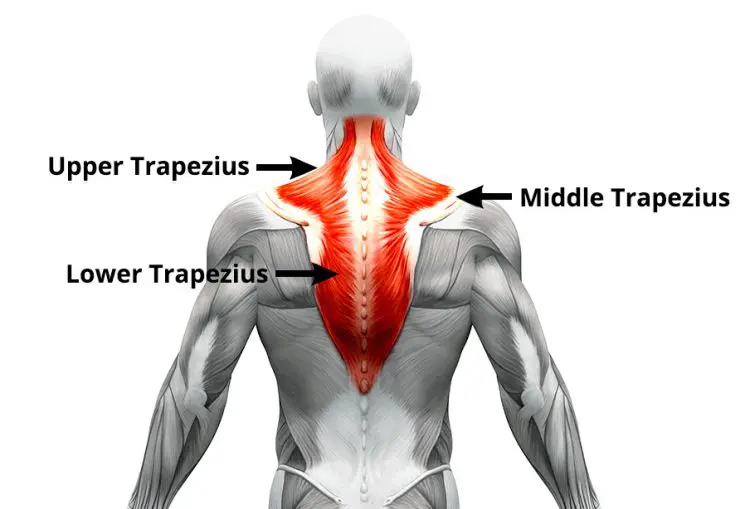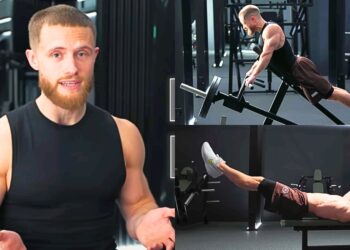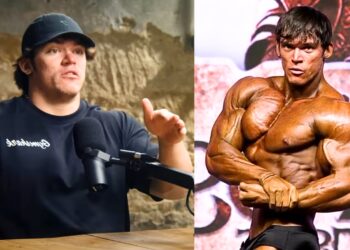The trapezius muscle, or traps, is the second biggest back muscle group after the lats. These triangular-shaped muscles extend from the base of the skull to the mid-back and laterally to the shoulder blades.
Traps are divided into three sections — upper, middle, and lower — and you must target them from different angles to build a thick, dense back. The good news is that you can get a complete trapezius workout with nothing but a pair of dumbbells. As an in-home personal trainer, I work with several clients who only have access to dumbbells.
In this article, I’ve carefully curated the 12 best dumbbell exercises you can do at home for complete trap development. So, get ready to unlock new levels of upper back strength and muscle gains.
Recent Updates: On May 27, 2024, Fitness Volt’s Senior Editor, Vidur Saini (ACE-CPT), revised the exercise list to include the most effective trapezius muscle exercises. We’ve also added actionable expert tips that you can implement immediately.
Level Up Your Fitness: Join our 💪 strong community in Fitness Volt Newsletter. Get daily inspiration, expert-backed workouts, nutrition tips, the latest in strength sports, and the support you need to reach your goals. Subscribe for free!
12 Best Dumbbell Exercises For Traps
This baker’s dozen trap dumbbell exercises will work every fiber of your trapezius, from the base of the neck to the mid-spine.
1. Dumbbell Shrug
| Sets & Reps | Equipment Needed | Target Muscles |
| 3 x 8-12 | Dumbbells | Upper trapezius, levator scapulae |
Dumbbell shrugs are among the best exercises to target the upper traps, as they perfectly simulate the direct upward motion of the target muscle group. This exercise can help develop thick, rounded, or long, streamlined traps between the neck and shoulders.
“Avoid dropping your head forward or back, as it can strain your neck,” cautions Saini. “Keep your spine, neck, and head neutral throughout the exercise.”
Step-by-Step Guide:
- Stand with a relatively heavy pair of dumbbells held at your sides. Your feet should be shoulder-width apart.
- Starting from a depressed shoulder position and keeping your arms straight (no elbow bend), shrug directly up as if you were bringing your shoulders to your ears.
- Lower under control, going directly back down (do not roll your shoulders).
Pro Tip: Think of ‘sliding’ your shoulder blades into your back pockets as you shrug upwards. This subtle cue helps engage the lower traps and prevent excessive neck involvement.
| Difficulty | Progression | Regression |
| Beginner | Increase weight, pause at the top of the movement | Use lighter dumbbells |
2. Unilateral Dumbbell Shrug
| Sets & Reps | Equipment Needed | Target Muscles |
| 3 x 8-12 per side | Dumbbell | Upper trapezius, levator scapulae (isolated per side) |
The unilateral dumbbell shrug involves doing the exercise one arm at a time, allowing more focused concentration of the target muscles. It also helps identify and iron out muscle and strength imbalances.
Think about pulling your shoulder blades toward your spine on the lifting phase, rather than just lifting it straight up, cues Saini.
Step-by-Step Guide:
- Grab a single dumbbell and hold it at your side. I recommend grabbing a beam or other upright support with your non-working hand for core stability.
- Starting from a depressed shoulder position and keeping your arm straight (no elbow bend), shrug directly up.
- Return to the starting position in a slow and controlled motion.
Pro Tip: Lean slightly away from the side holding the dumbbell. This slight angle creates a greater stretch in the upper trapezius, leading to a more pronounced contraction at the top.
[/sc]
| Difficulty | Progression | Regression |
| Beginner | Increase weight, slow down the eccentric (lowering) phase | Use lighter dumbbells or no weight |
3. Dumbbell Upright Row
| Sets & Reps | Equipment Needed | Target Muscles |
| 3 x 8-12 | Dumbbells | Upper trapezius, lateral deltoids |
The dumbbell upright row works the medial deltoids and upper traps equally. As such, it promotes even development above the chest. Focus on drilling the movement mechanics before lifting heavier weights.
Saini highlights that the eccentric phase of this exercise is as important as the concentric. Spend 2-3 seconds on the descent to maximize target muscle stimulation.
Step-by-Step Guide:
- Grab a pair of dumbbells and hold them in front of your body, with your palms facing your body.
- Maintain an upright torso with a naturally arched back. Your feet should be shoulder-width apart.
- Pull the dumbbells directly up toward your chin. Your upper arms should be parallel to the floor at the top.
- Lower under control, maintaining an upright position (no swinging or momentum).
Pro Tip: Imagine pulling the dumbbells diagonally towards your ears instead of pulling straight up. This engages the lateral deltoids more effectively and minimizes strain on the wrists.
| Difficulty | Progression | Regression |
| Intermediate | Barbell upright row | Use a wider grip (hands further apart), lighter weight |
4. Dumbbell High Pull
| Sets & Reps | Equipment Needed | Target Muscles |
| 3 x 6-8 | Dumbbells | Upper trapezius, lateral deltoids, rhomboids, biceps brachii |
This upright row variation is intended to develop more explosive power in the traps and deltoids. Try this exercise only after you’ve mastered the upright row.
Saini recommends always leading with your elbows on the trapezius exercise, like the upright row. This cue helps engage the most powerful upper back muscles and limits bicep recruitment.
Step-by-Step Guide:
- Grab a pair of dumbbells and hold them in front of your body, with your palms placed against your thighs.
- Maintain an upright torso and place your feet should be shoulder-width apart.
- Flex at the hips to lower the dumbbells to knee level. Your upper back should remain neutral so your torso is at 45 degrees.
- Extend your hips and lift your heels as you explosively pull the dumbbells up to your chin level.
- Lower under control to the start position.
Pro Tip: Be as explosive as you can on the concentric phase. Advanced exercisers can use lifting straps to eliminate their grip strength and focus on engaging the target muscles.
| Difficulty | Progression | Regression |
| Intermediate | Perform with a barbell, increase weight, focus on explosiveness | Use lighter dumbbells, slow down the movement |
5. Dumbbell Reverse Flye
| Sets & Reps | Equipment Needed | Target Muscles |
| 3 x 10-15 | Dumbbells | Middle trapezius, posterior deltoids, rhomboids |
This movement targets the outer part of the mid traps along with the rear delts. This exercise will help enhance your back width and achieve the coveted 3D aesthetics. Focus on keeping the scapula retracted throughout the range of motion (ROM) to maximize middle trap engagement.
Step-by-Step Guide:
- Stand with your feet shoulder-width apart and a pair of dumbbells in your hands, palms facing each other.
- Hinge at the hips and lean forward so your upper body is at 45 degrees.
- Bring your elbows to your sides by driving them toward the ceiling. At the same time, squeeze your shoulder blades together.
- Lower to the start position under control.
Pro Tip: Externally rotate your shoulders (as if you were trying to show off your armpits) as you lift the dumbbells to maximize target muscle activation.
| Difficulty | Progression | Regression |
| Beginner | Perform on an incline bench with heavier weights | Keep the movement slow and controlled |
6. Dumbbell Farmer’s Walk
| Sets & Reps | Equipment Needed | Target Muscles |
| 3 x 20-30 meters | Dumbbells | Traps, forearms, erector spinae, core, grip strength |
The dumbbell farmer’s walk is a functional movement that works the mid traps, deltoids, core, and grip. I recommend using heavier dumbbells for this exercise, as it will load your trap muscles more.
“Folks trying to bias their traps in this exercise can use lifting straps and opt for heavier dumbbells,” says Saini.
Step-by-Step Guide:
- Grab a heavy pair of dumbbells off the rack and hold them at your sides.
- Walk around your workout area, taking 20 paces away from the dumbbell rack and then returning. This should take between 10 to 60 seconds.
- Replace the dumbbells on the rack.
Pro Tip: Maintain a tight core and proud chest throughout the walk to load the traps and limit spinal strain.
| Difficulty | Progression | Regression |
| Beginner | Increase weight, distance, or walking speed | Use lighter dumbbells, shorten the distance |
7. Dumbbell Hang Power Clean
| Sets & Reps | Equipment Needed | Target Muscles |
| 3 x 5-6 | Dumbbells | Upper body |
The dumbbell hang power cleans are an upright row and high pull hybrid. The more upright stance and lower body engagement allow you to lift heavier, leading to greater trap stimulation. Since this is a high-skill movement, I highly recommend beginners seek a personal trainer’s help to maximize target muscle stimulation and limit injury risk.
Step-by-Step Guide:
- Stand upright with a hip-width stance, holding a dumbbell in each hand with a neutral grip against your thighs.
- Slightly flex your knees and hips while keeping your back flat, and lower the dumbbells toward the ground.
- Explosively extend your hips, knees, and ankles, and pull the dumbbells up your body.
- As the dumbbells reach your shoulders, shrug your shoulders and dip under them, catching them in a clean rack position with your elbows bent and palms facing each other.
Level Up Your Fitness: Join our 💪 strong community in Fitness Volt Newsletter. Get daily inspiration, expert-backed workouts, nutrition tips, the latest in strength sports, and the support you need to reach your goals. Subscribe for free! Pro Tip: Keep your scapula retracted throughout the motion to bias the traps.
| Difficulty | Progression | Regression |
| Advanced | Use a barbell, increase weights | Dumbbell upright row |
8. Dumbbell Hanging Scapular Shrugs
| Sets & Reps | Equipment Needed | Target Muscles |
| 3 x 15-20 | Pull-up bar, dip belt, dumbbell | Lower trapezius, serratus anterior |
Contrary to what most think, you don’t need heavy dumbbells to train the traps. All you need is some imagination. Your own body weight is enough to annihilate the traps. You will need a dip belt for this exercise. Alternatively, you could hold a dumbbell between your ankles if you don’t have access to a dip belt.
Step-by-Step Guide:
- Wear a dip belt and add an appropriate dumbbell.
- Grab a pull-up bar with a shoulder-wide overhand grip.
- Your elbows and shoulders should be fully extended in the starting position.
- Depress your shoulder blades and pull them together as if trying to touch them to your back pockets.
- Raise your body slightly and hold the top position for at least a few seconds.
- Slowly return to the starting position.
Pro Tip: Pull the shoulder blades back and down to pre-activate the lower traps and achieve a more isolated contraction.
| Difficulty | Progression | Regression |
| Beginner | Add weight with a dip belt | Perform with feet on the ground |
9. Dumbbell Overhead Shrugs
| Sets & Reps | Equipment Needed | Target Muscles |
| 3 x 8-12 | Dumbbells | Upper trapezius, levator scapulae, serratus anterior, core |
Are you tired of the conventional dumbbell shrugs and looking for a challenge? I’ve got you covered. Holding the dumbbells in the overhead position puts additional load on the traps, which can lead to new adaptations.
“Do not press the dumbbells together at the top,” Saini says. “Keeping the dumbbells apart will lead to greater core stabilizer engagement.”
Step-by-Step Guide:
- Grab a dumbbell in each hand and stand upright with a hip-width stance.
- Lift the dumbbells overhead with your elbows and shoulders fully extended. Your wrists should be facing forward.
- Slowly pull the shoulder blades back and down and feel a deep stretch in the trap muscles.
- Explode back to the starting position.
Pro Tip: Focus on following a full ROM for maximum trap engagement.
| Difficulty | Progression | Regression |
| Intermediate | Increase weight, slow down the eccentric phase | Use lighter dumbbells, reduce the range of motion |
10. Incline Dumbbell Shrugs
| Sets & Reps | Equipment Needed | Target Muscles |
| 3 x 8-12 | Dumbbells, incline bench | Upper trapezius |
This dumbbell shrug variation involves lying prone on an incline bench, which maximizes upper trap stimulation. Saini recommends lowering the dumbbells toward the floor until you feel a deep stretch in the trap muscles.
Step-by-Step Guide:
- Set an incline bench at 45 degrees.
- Grab a dumbbell in each hand and place your chest against the bench’s pad.
- Depending on your comfort level, pick between a pronated or neutral grip.
- Fully extend your shoulders to lower the dumbbells toward the floor.
- Pull your shoulder blades back and down on the concentric phase.
- Repeat for reps.
Pro Tip: Pause at the top of your ROM for peak isometric contraction. Plus, avoid rounding your shoulders at the bottom.
| Difficulty | Progression | Regression |
| Beginner | Increase weight | Perform seated on a flat bench |
11. Dumbbell Face Pull
| Sets & Reps | Equipment Needed | Target Muscles |
| 3 x 10-15 | Dumbbells | Middle and upper trapezius, biceps brachii, Posterior deltoids, rhomboids |
This often neglected exercise can toast your traps and rear delts in no time. I recommend using lighter weights in this exercise to maximize target muscle stimulation.
Step-by-Step Guide:
- Stand upright with a shoulder-wide stance and a dumbbell in each hand.
- Hinge at the hip and lower your torso toward the floor until it is almost parallel.
- Drive your elbows toward your ears and the ceiling to engage the middle and upper traps.
- Slowly lower to the starting position.
Pro Tip: Keep your elbows as wide as possible on the ascent to maximize the trap engagement.
| Difficulty | Progression | Regression |
| Beginner | Increase weight, slow eccentric | Keep the movement controlled |
12. Dumbbell Cuban Press
| Sets & Reps | Equipment Needed | Target Muscles |
| 3 x 8-12 | Dumbbells | Upper trapezius, lateral and posterior deltoids, biceps brachii |
This exercise combines an upright row, external rotation, and shoulder press. You couldn’t have asked for a more challenging shoulder exercise.
“Pause briefly at the top of each repetition when your hands are in line with your ears before externally rotating the shoulders,” says Saini. This will lead to greater trap engagement.
Step-by-Step Guide:
- Pick a relatively light pair of dumbbells and stand erect.
- Pull the dumbbells to your shoulder level by driving your elbows up and out.
- Rotate the dumbbells up towards your ears while squeezing your abs and keeping the rest of your body still.
- Press the dumbbells overhead to lockout.
- Slowly return to the starting position.
Pro Tip: Use lighter weights to avoid straining the rotator cuff muscles.
| Difficulty | Progression | Regression |
| Advanced | Slow eccentric | Upright row |
Trapezius Anatomy

The trapezius muscle fibers originate on the upper two-thirds of the spine, from the base of the skull down to the lower thoracic vertebrae. The fibers then extend laterally, converging and attaching to the outside of the shoulder blade.
The function of the upper trap fibers is to pull the shoulder blades and clavicles up toward the ears. The mid fibers pull the shoulder blades back to the spine, while the lower fibers pull them down and in. You need to do exercises replicating each of these movements to work all muscle areas.
When most people think of the traps, they picture only the upper part of the muscle. That’s the sloping part between the neck and shoulders. Genetics plays a significant role in how much the upper traps can be developed and the shape they take. Some bodybuilders, like Dorian Yates, Ronnie Coleman, and Kai Greene, had huge, rounded upper traps, while others, such as Frank Zane, Bob Paris, and Shawn Ray, had longer, more streamlined upper traps.
Benefits of Dumbbell Trap Exercises
Here are the advantages of the dumbbell trap exercises:
- Targeted Isolation: Dumbbells allow you to target the trapezius muscle and to work specific areas, such as the upper and mid. This muscle responds well to isolated movement, and dumbbells allow for it better than machines or barbells.
- Balanced Development: There are two sides of the trapezius muscle. If you don’t work them individually, it is easy for the stronger side to take over when you’re doing exercises like barbell shrugs. Unlike barbells, dumbbells force each side of the muscle to take its own load, ensuring balanced development.
- Range of Motion: Moving the working muscles through a complete range of motion is essential for optimal development. You will get a fuller range of motion with dumbbells than machines or barbells.
- Recruits Stabilizer Muscles: When you train with dumbbells, your body has to use stabilizer muscles to maintain balance and control. This improves functional strength and coordination.
- Convenience: Dumbbells are a relatively cost-effective training tool. Most home gyms have at least one set, and most gyms have plenty, so they are available even during rush hours.
FAQs
Can I build massive traps just using dumbbells?
Yes, you can build huge traps with just dumbbells. You’ll be able to get a full range of motion and isolate each side of the traps with dumbbells. The extent to which you can build size and roundness in the traps, however, is largely determined by genetics. Some people tend more toward longer, more streamlined traps than bulky ones.
How often should I train my traps?
You should train your trapezius muscles twice per week, with a gap of 48-72 hours between sessions. Each workout should consist of 8-10 sets.
What is the best rep range for training traps?
You should use a wide rep range to work both the fast and slow twitch muscle fibers in your traps. I recommend a pyramid rep system where you increase the weights and lower the reps on each succeeding set. Here is a five-step scheme that works well:
- Set One: 20 reps
- Set Two: 15 reps
- Set Three: 12 reps
- Set Four: 10 reps
- Set Five: 8 reps
Will trap exercises with dumbbells help improve my posture?
Yes, trap exercises can help improve your posture. By strengthening your upper and mid trapezius muscles, you will support the muscles that help promote a good posture. Other exercises that promote flexibility and core strength will also help with your posture.
How long before I see results in my trap development?
The time it takes to see results in trap development depends on several variables, including genetics, nutrition, training intensity, and training consistency. Most people should see development in the front traps after 4-6 months of training.
Summary
The trapezius muscle is the second largest in the back, taking up two-thirds of the upper-mid back. From the front, the upper traps fill up the space between the neck and the shoulders.
You’ve now got an arsenal of 13 effective exercises to hit the traps from every angle with just dumbbells. Make the most of this knowledge by creating your own workouts, consisting of two to three exercises and ten sets. Do two trap workouts a week, tagged on to your lat workout, and you’ll soon start developing the thickness, detail, and mass that are the hallmarks of next-level back development.
Interested in measuring your progress? Check out our strength standards for Dumbbell Reverse Fly, Face Pull, Upright Row, and more.









